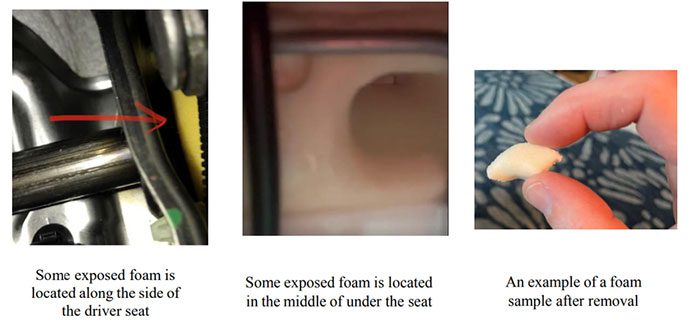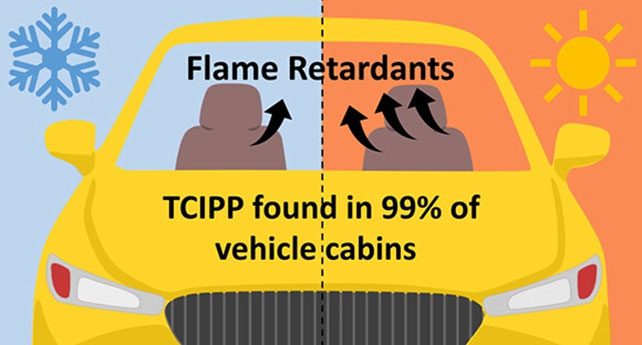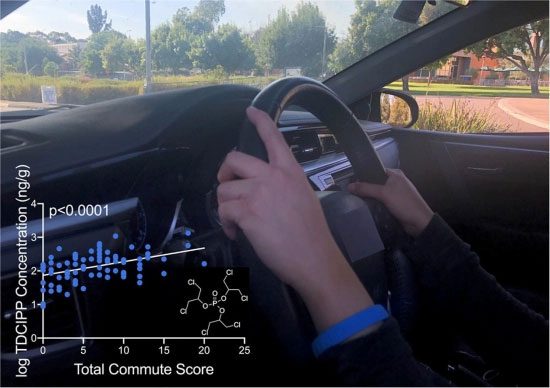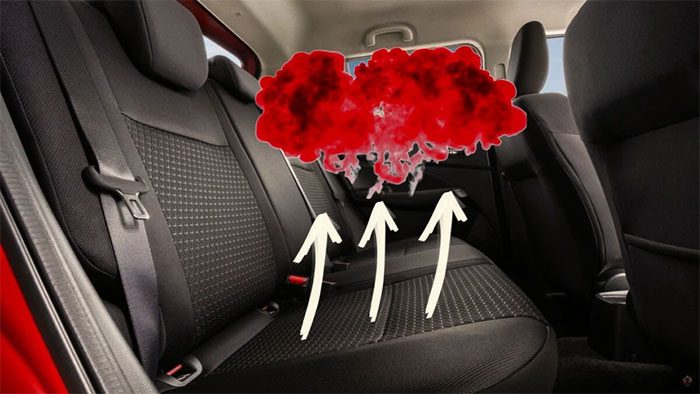According to a new study published in the journal Environmental Science & Technology, the air inside 99% of personal vehicles is exposed to a potentially carcinogenic compound called TCIPP.
This compound originates from flame retardants, which car manufacturers add to seat cushion foam, mix into plastic components, and electronics found in car interiors to meet fire safety standards upon leaving the factory.
However, scientists believe that these fire safety standards are currently outdated. When car manufacturers add flame retardants to car interiors, they not only fail to prove their fire prevention benefits but also create toxic fumes, especially when volatile compounds are released under hot conditions.

This compound originates from flame retardants. (Illustration).
“Our research found that materials used in car interiors release harmful chemicals into the air inside the car cabin“, said Dr. Rebecca Hoehn, the lead author of the study and an environmental toxicologist from Duke University.
“On average, a driver spends about 1 hour in their car each day, and with the concentration of this compound, it poses a serious public health issue. This is particularly concerning for drivers with longer commutes, as well as for passengers who are children, who breathe in more air than adults.”
How was TCIPP discovered?
In their study, scientists recruited 101 car owners in the United States who purchased vehicles between 2015 and 2022. The recruitment process was random, resulting in 26 electric vehicle owners, 49 gasoline vehicle owners, and 26 hybrid vehicle owners participating.
Since the car owners lived in various states, scientists mailed them a sampling kit. The kit included gloves, aluminum zip bags, and a silicone ring (a standard sampling device in science, capable of absorbing gas compounds from the environment):

Illustration from the study.
Car owners were instructed to read the guidelines that accompanied the kit, wear gloves, remove the silicone ring, and hang it from the rearview mirror inside their car for a continuous period of 7 days. After the 7 days, they would put on gloves again, remove the silicone ring, wrap it in aluminum foil, and place all samples into a zip bag to send back to the laboratory at Duke University.
In addition to the silicone ring sample, 52 car owners were also asked to collect a small piece of foam about 1 cm from their driver’s seat. Scientists guided them to easily access the foam from the area beneath the car seat.
This foam piece was then wrapped in clean aluminum foil, placed in a zip bag, and sent back to the laboratory.

Illustration.
In their laboratory, Dr. Hoehn and her colleagues used specialized methods to extract the compounds found in the collected silicone samples and seat foam. They then employed chromatography to search for potential harmful substances, along with their concentrations.
The results showed that 99% of the 101 sampled vehicles contained tris (1-chloro-isopropyl) phosphate (TCIPP), a flame retardant currently being investigated by the U.S. National Toxicology Program as a potential carcinogen.
Most vehicles also contained organophosphate flame retardants, including tris (1,3-dichloro-2-propyl) phosphate (TDCIPP) and tris (2-chloroethyl) phosphate (TCEP), both classified as carcinogens under California’s Proposition 65. These substances, along with 17 other flame retardants detected in vehicle cabin air, pose risks to human neurological and reproductive health.

Hot weather in summer increases concentrations of flame retardants by 1.6 to 5.3 times.
There was a direct correlation, meaning that cars with higher TCIPP concentrations in the seat foam also had higher TCIPP levels in the cabin air. This confirms that seat foam is a source of this flame retardant as it escapes into the car cabin, especially in summer when car seats can heat up to 65 degrees Celsius.
Approximately half of the tested vehicles were sampled in both summer and winter. During the hotter summer months, the concentrations of flame retardants detected by the research team were 1.6 to 5.3 times higher.
Notably, a comparison between gasoline, electric, and hybrid vehicles showed that while electric vehicles had TCIPP levels 3-6 times lower than gasoline vehicles, surprisingly, hybrid vehicles had the highest TCIPP concentrations, ranging from 8-14 times compared to electric vehicles.
The Dangers of Volatile Flame Retardants
While the vehicles involved in the study were produced in various countries, including the U.S., Japan, Germany, and South Korea, they were sold in the U.S. and therefore had to meet the Federal Motor Vehicle Safety Standards (FMVSS) 302 set by the National Highway Traffic Safety Administration (NHTSA).
The FMVSS 302 standard includes a flammability section, which tests exposure to flames in an open space. To pass this section, car manufacturers typically mix flame retardants into seat foam, plastic components, and electronics in vehicles to reduce their flammability.
Unfortunately, these flame retardants also have drawbacks, potentially impacting the health of vehicle users. A 2011 study using zebrafish as a model showed that exposure to flame retardants could reduce reproductive capabilities and hinder normal fish embryo development.
Meanwhile, some tests with TCIPP on mouse models have indicated that it is a compound that can cause cancer.

Illustration.
Patrick Morrison, who oversees Health and Safety for 350,000 firefighters in the U.S. and Canada at the International Association of Fire Fighters, stated:
“Firefighters are concerned that flame retardants contribute to their increased cancer rates. Filling products with these toxic chemicals does not prevent fires in most use cases; rather, it makes the fire smokier and more toxic for victims, especially for first responders.”
Based on findings from the new study, Morrison urges the National Highway Traffic Safety Administration to update their vehicle fire safety standards, a regulation established in 1970 that is now outdated.
California has previously updated its fire safety standards for certain products, such as furniture and children’s toys. Epidemiological studies have shown that, on average, a child in the U.S. loses 3 to 5 IQ points due to exposure to a flame retardant used in cars and furniture.
Furthermore, a recent research paper estimated that individuals with the highest levels of these flame retardants in their blood are four times more likely to die from cancer than those with the lowest levels.
Now, the question arises: What can you do if your car still contains these flame retardants?

Parking outdoors on hot summer days can increase TCIPP concentrations. (Illustration).
Lydia Jahl, a senior scientist at the Green Science Policy Institute and one of the co-authors of the study, stated: “You can reduce exposure to flame retardants in your car by opening windows and parking in the shade.“
Parking outdoors on hot summer days can increase the concentration of volatile flame retardants released from the vehicle’s interior and affect your health. If you must park in direct sunlight, you should use your car’s remote start feature, turn on the air conditioning, and bring in outside air to dilute the cabin air.
“But what is really necessary is to reduce the amount of flame retardants added to cars in the first place,” Lydia said. “Driving to work every day should not increase cancer risk, and children should not be inhaling chemicals that could harm their brains on their way to school.”




















































